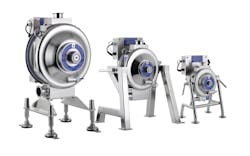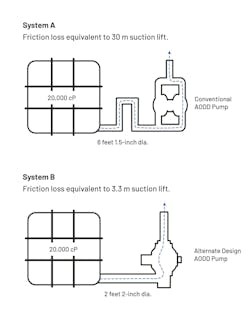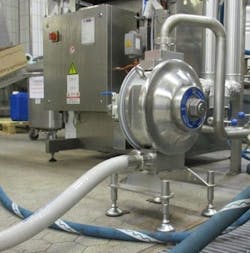In the thick of it: Pumping high-viscosity liquids with an AODD pump
Many processes involve the hygienic transfer of viscous products, from sauces to silicone. These thick materials pose special challenges to the pumping process. An improperly designed system may deliver slow flow rates, cause cavitation within the pump, create time-consuming jams and cause excessive pump wear. Fortunately, engineering principles are easy to grasp, and once understood, they can help engineers avoid common mistakes. This article explains the issues of pumping high-viscosity materials and how to approach them best.
The general design of a typical transfer system is a storage vessel, suction pipework, a pump and delivery pipework. Commonly, the hygienic pumps used with high-viscosity liquids are air-operated double-diaphragm (AODD) pumps.
Start where the product enters the process
Usually, the material enters the system from a storage vessel such as a drum, tote or intermediate bulk container (IBC). With a light-viscosity product, normal atmospheric pressure (1 bar) is enough to push the product into the lance of the suction pipework. Once the pump is flooded, it can move the product. With a high-viscosity material, however, normal atmospheric pressure may not be enough to flood the pump. Instead, the lance digs a hole in the product.
If the material is in a drum, the operator can use a barrel unloader. It pushes a follower plate attached to the pump inlet onto the surface of the material. This approach eliminates suction pipe friction losses and helps the product to level out in the drum as it is being drawn into the pump. If atmospheric pressure is insufficient to force product through the suction pipework between a sealed container and the pump, then additional pressure can be put onto the top of the product to help push it through the pipework. Note that the vessel must be sealed, and care should be taken when charging containers. Typically, air is introduced at the top of the vessel through a hose. Nitrogen (supplied from gas cylinders) may be preferred over air because, unlike air that contains oxygen, nitrogen gas is inert and does not react with a product. Increasing atmospheric pressure from 1 bar to 2 bar is like adding a 30-foot (9-meter) column of water on top of the material. The amount of pressure required depends on the viscosity.
Make friction loss calculations
Imagine the engineer at a food processing plant who learns that a new material — tomato paste having a viscosity of 100,000 cP — will be added to the process. The engineer needs to know if the existing AODD pump is up to the task or if a new pump will be needed, and if so, what size pump to specify. Before specifying the pump, the engineer must understand the internal friction losses of the pipework and pump. If the friction loss is too high, then a high-viscosity material will not move through the pump and pipework at the desired flow rate and perhaps not move at all.
While any engineer with a mechanical mindset could apply the required equations, industry professionals always use a friction loss calculator. Enter variables such as the pipework diameter, length of pipe, number of pipe bends and height of the lift, and the calculator does the work. The answer is expressed in terms of dynamic head: the difference between head pressure on the suction end of the system and the head pressure on the delivery end of the system.
The viscosity and temperature of the material are critical variables in these calculations. Some materials, such as fruit puree, are pumped at near-freezing temperatures, which increases their viscosity. Some materials, such as ointment, are pumped warm; after receiving the ointment, operators store it in a warm room to bring it to working temperature. The best example is chocolate. At room temperature, it is solid, and it will jam pumps and pipework. For transfer, operators heat the chocolate to 32°C, reducing its viscosity to around 15,000 cP so it can flow. Heating jackets are available as a pump accessory.
Often, the process engineer does not know the centipoise of the product they will be pumping. Sometimes, the engineer can obtain the centipoise from their material suppliers. The most accurate method is to test a sample of the material. Some quality pump vendors have the capability to test viscosity. In the worst case, the engineer can compare their material to a foodstuff with a known viscosity for an approximate centipoise value.
Know the engineering tradeoffs
After entering the viscosity and other variables into the friction loss calculator, the engineering tradeoffs emerge. Suppose that the facility has 3 feet of 2-inch-diameter pipework on the suction line and 10 feet of 2-inch-diameter pipework on the delivery line rising to a height of 6 feet. The calculations may show that the internal friction is too high to achieve the desired flow rate. Using the existing pipework, the best achievable flow rate of tomato paste having 100,000 cP may be 10 gallons (38 liters) per minute. By changing the pipework to a 3-inch diameter, the maximum flow rate may increase to 25 gallons (94 liters) per minute.
If the viscosity rises, then the flow rate falls. For example, pumping a silicone cream having 500,000 cP through this system with 3-inch diameter pipework may yield only 10 gallons (38 liters) per minute.
Size the pump based on flow rate
Pump sizing depends on the required flow rate. In a system with 3-inch diameter pipework, the desired flow rate may be achievable in a pump having 2-inch connections. The smaller pump reduces costs. First, understand the internal friction loss and then see what size pump will deliver the needed flow rate.
Consider pump speed
Viscous products are more likely to experience cavitation, where the pump’s movement creates air pockets in the product. The solution is to slow the speed of the pump. In a low-viscosity process, an AODD pump may operate at 4-5 strokes per second. In a high-viscosity process, the pump may be set to operate at only one stroke per second. Of course, the slower speed affects the flow rate, and larger pipework may be needed to compensate.
Understand suction lift
One of the most misunderstood aspects of pumping high-viscosity fluids, even among pump manufacturers, is the suction lift. For a typical AODD pump, the maximum suction lift is 12 feet (3.6 meters). Another way of saying this is that the pump has a vacuum of 12 feet (3.6 meters). If the friction losses exceed the equivalent of 12 feet (3.6 meters) of suction lift, then the application will not work. The goal is to design a system with friction losses below 0.4 bar. If the friction loss is too high, then the engineer must redesign the pipework by increasing the diameter, shortening runs and removing bends (Figure 1).
Put it all together: a case study
A large cosmetics processor was experiencing challenges with transferring their finished products to filling stations. The products had viscosities ranging from 100 to 100,000 cP. To meet productivity goals, the plant operators needed a certain flow rate, but they were unable to achieve it because of internal friction loss and because they had to reduce pump speed to avoid cavitation within the pump. Also, they were concerned that the pumps were required to perform at the maximum of their suction capabilities, which could shorten the life of the pumps and increase maintenance costs.
The storage containers were located on the mezzanine along with 20 transfer pumps that were transferring the various products to filling lines on the floor below.
The system was configured as follows:
- Suction line
o 1.5-inch diameter pipework.
o 6-foot (2-meter) run to the pump.
- AODD pump (with conventional pump pipework).
- Discharge line.
o 1.5-inch diameter pipework.
o 10-foot (3-meter) run to a filling station.
Although plant operators had recently invested in 20 new pumps for this application, they were unhappy with their performance and consulted a different pump manufacturer to explore possible solutions.
Engineers at the pump manufacturer sought to understand the application by entering the variables into their friction loss calculator. With the high viscosity of the product involved, they discovered that the internal friction of the pipework and pumps was too high for efficient product transfer. The engineers recommended that the processor reconfigure and replace its pipework.
The cosmetics processor increased all pipework to 2 inches in diameter and located the pumps closer to the ICBs, shortening the suction line to 2 feet (0.6 meters).
In addition, the operators replaced their 20 AODD pumps having a conventional design with an alternative style AODD pump that offered lower internal friction. A conventional AODD pump includes pipework on each side of the diaphragms, giving the pump the appearance of a figure eight. An alternative design routes the process fluid through the center of the pump. This innovative design eliminates the friction of the figure eight of pipework and offers a short, nearly straight path for process fluid (Figure 2).
In this high-viscosity application, the combination of reconfigured pipework and new pumps gave operators the flow rates they desired, reduced the wear on pumps and lowered energy costs.
To be fair, efficiency was not the only justification for the investment in new pumps and pipework. Unlike the original pumps, the new pumps were able to be cleaned-in-placed (CIP) when changing products. Before the changeout, workers had to disassemble the pumps, carry the parts to the cleaning room, manually clean them, carry them back up to the mezzanine and reassemble the pumps. With up to 10 product changes per day, this process consumed as much as 30 hours daily. By switching to a CIP-able pump, the Flotronic One-Nut pump from Unibloc Hygienic Technologies, the processor saved considerable labor. The new pumps were able to handle the high pressures of the CIP system, cutting labor to a little more than 4 hours.
Additionally, because the product remained in the pipework of the original pumps, significant waste occurred during each cleaning cycle. The new pump minimizes product waste, which in the case of cosmetics can be valued at as much as $100 per ounce.


